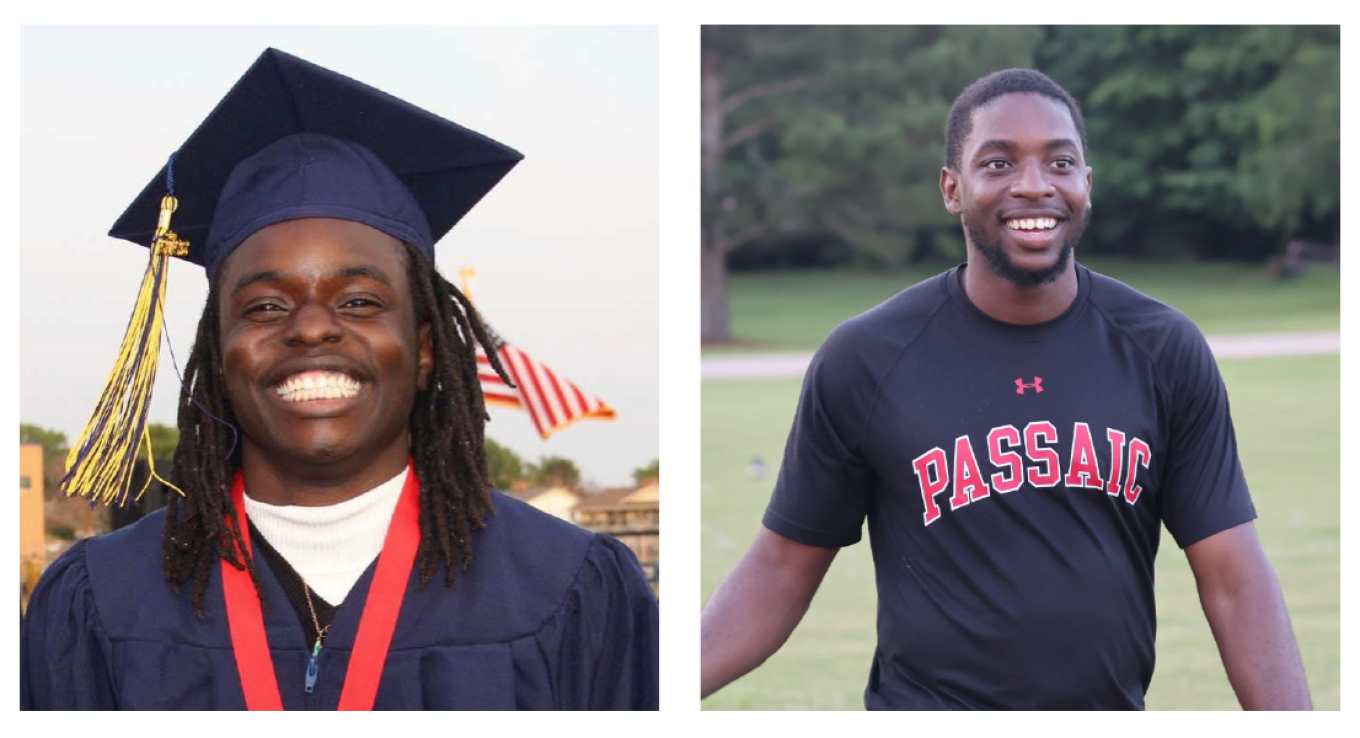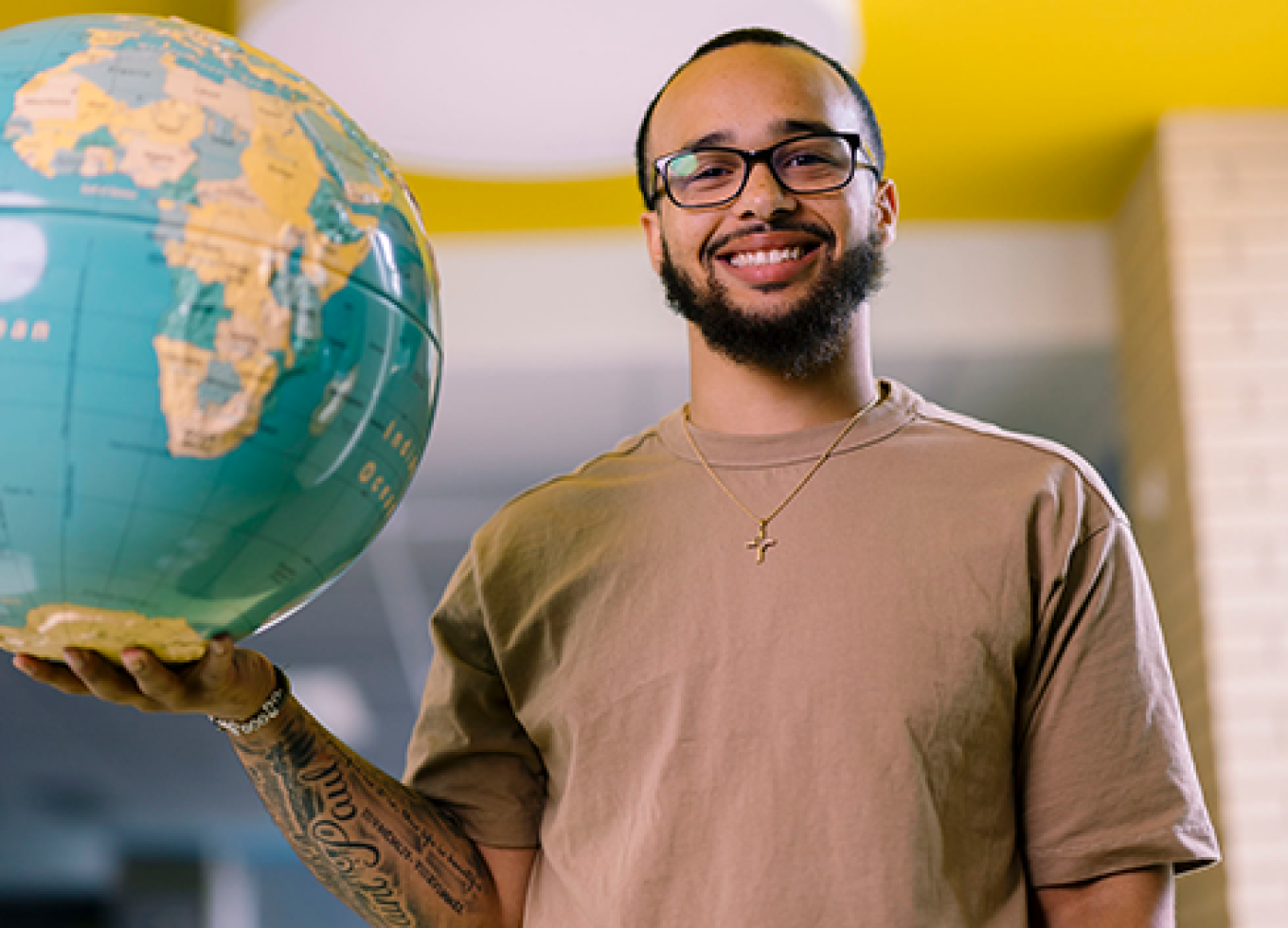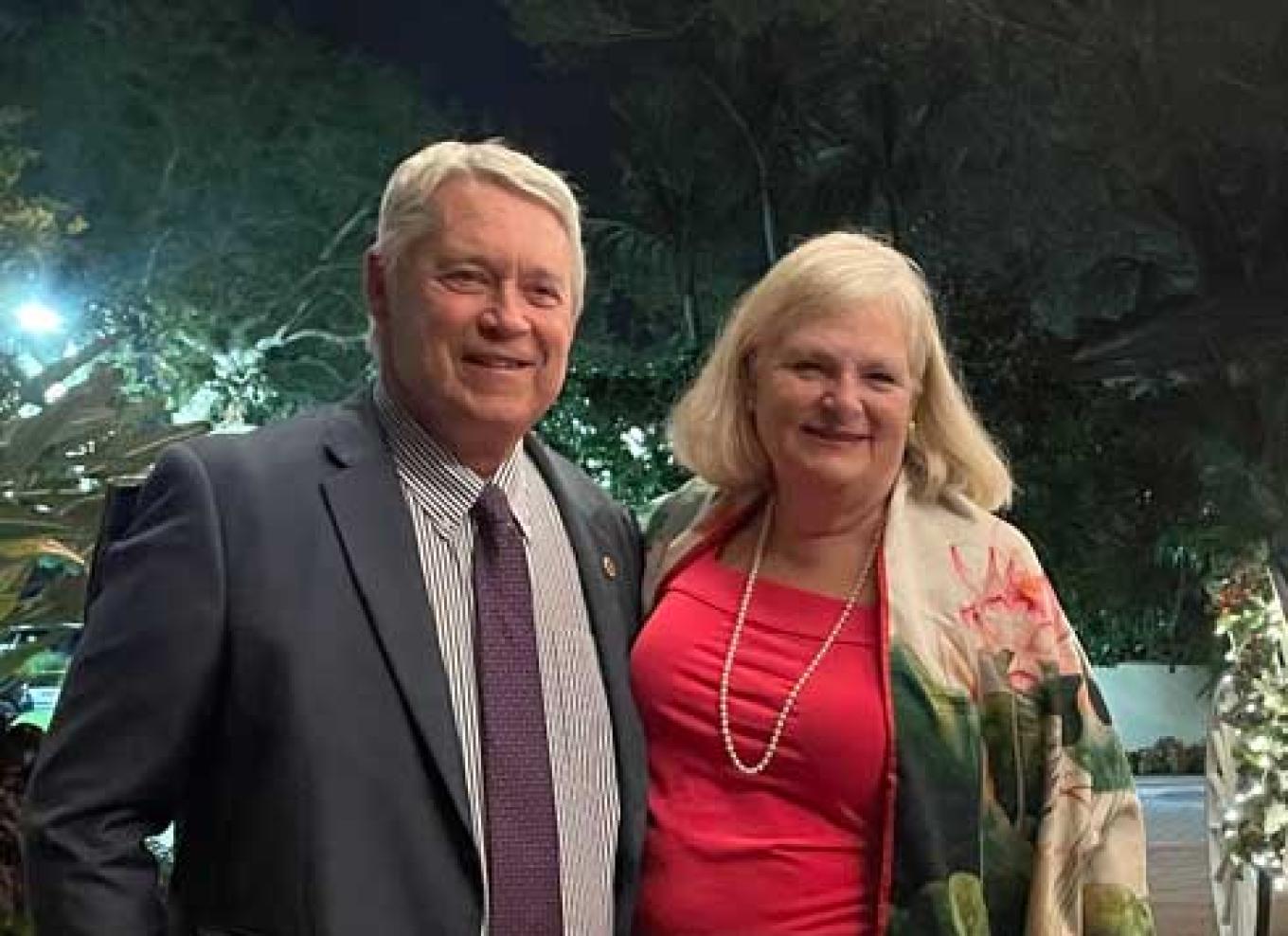Black educators matter
Watch a video to learn more about Black Men Teach and hear from Executive Director Markus Flynn. (video by Jairus Davis)
BLACK MEN TEACH AND CEHD AIM TO MAKE MINNESOTA SCHOOLS MORE REFLECTIVE OF THEIR STUDENTS
All the way from kindergarten through his first year at the University of Minnesota, Marqkye Pitts has never had an educator with the same ethnic background as him. “I often wonder how my experience might have been different with such a presence in the classroom,” he says. “My current motivation is to be that presence for the next generation of students.”
Pitts is currently an elementary education student at CEHD, part of an initiative to get more Black male teachers in Minnesota classrooms, particularly in the elementary school grades.
Recent studies have demonstrated that Black students who are exposed to Black teachers have a much greater chance of academic success. One study, “The Long-Run Impacts of Same-Race Teachers” (American Economic Journal: Economic Policy, 2022), found that Black students having at least one Black teacher in kindergarten through third grade are 13 percent more likely to graduate from high school and 19 percent more likely to enroll in college compared to Black students who did not have the presence of a Black teacher.
In a working paper, “Why Black Teachers Matter,” University of Maryland College Park Researcher David Blazar found that students of color in fourth or fifth grade who were assigned a teacher of color increased their math and reading achievement and reported higher levels of self-efficacy and class engagement. They were also less likely to be chronically absent.
“If you talk to enough people in the community, you realize that one of the more pressing challenges is how disparate our education outcomes are,” says Markus Flynn, the executive director of Black Men Teach (BMT), a Minnesota-based non-profit formed in 2018 and committed to increasing the number of Black male teachers in state schools. “Our Black students are performing low, despite the fact that Minnesota ranks relatively well across the nation academically.”
Of all the K-12 teachers in the state, only half a percent are Black men. BMT aims to turn that around. “The mission is to recruit, prepare, place, and retain Black male teachers in elementary school classrooms,” Flynn says.
The mission is to recruit, prepare, place, and retain Black male teachers in elementary school classrooms.
BMT’s plan is to target those elementary schools that have at least a 40 percent Black student population and increase the number of Black male teachers in each to 20 percent. Put into real numbers, there are roughly 90 elementary schools that meet the criteria. Of these schools, there are less than 50 Black male teachers. For BMT to reach its goal, it needs to place approximately 450 teachers into these schools.
To assist in achieving this objective, BMT formed a coalition of like-minded entities. “We spent about a year developing strategies and the coalition is composed of organizations that have the ability to execute those strategies,” Flynn says. “I don’t think it’ll be easy, but everyone’s at the table willing to lean in. I do think, though, it will be considered unprecedented.”
One partner working with BMT is the Columbia Heights School District. The district serves 3,400 students preK-12 in an inner-ring suburb of Minneapolis. “Our mission is to create worlds of opportunity for each and every learner,” said Superintendent Zena Stenvik, who spoke about the district’s partnership with BMT at CEHD’s recent Leading in Equity, Action, and Diversity (LEAD) conference.

Left: Marqkye Pitts is all smiles after graduating high school. He is now pursuing an elementary education degree at CEHD. Right: Tevin Thompson is a retired track and field athlete looking to become an elementary school teacher. (Photos courtesy of students)

District third-grade teacher Devon Minke, who also spoke at LEAD, reflected on what BMT means to him. “The one word I use is community,” he said. Minke was a student at Mankato State University when he met Flynn and learned about BMT. “Going to Mankato I was really lost. I was trying to find my community,” he said. “BMT became an important part of my community—to be able to ask questions, to let myself be my full authentic self, to allow me to be confident.” (After the LEAD conference, Minke sat down for an extended interview. See A conversation with Devon Minke).
Flynn helped Minke secure a position at Heights’ North Park School for Innovation as well as for his classmate, Keondre Lewis. Unlike Minke, who admits he had never heard of Columbia Heights prior to teaching there, Lewis is a blue and gold Hylander, class of 2018. He planned to major in elementary education after he graduated high school and found BMT to be just what he was looking for.
“Markus reached out to me during my junior year of college,” Lewis explains. “He asked me to join the program. From there I knew that it was a great fit for me as its mission was to get more Black men into schools and this was one of the biggest reasons I went into education.”
What makes BMT unique, Lewis says, is the support it provides, including scholarships, student teaching stipends, loan forgiveness, and even a pathway to homeownership. “I feel like I have been able to get comfortable quickly as a teacher due to the support of BMT,” he says. “I have been able to think about my next step and I decided to pursue leadership in education. I hope to continue to serve minoritized students in as many ways as possible by being a leader in the spaces that I am in.”
Finding a college partner
Flynn says at one point, BMT was having some internal discussions about getting more students from HBCU (Historically Black Colleges and Universities) to the state. Perhaps a conversation with the University of Minnesota might be helpful. Coincidentally, similar thoughts were taking place at the U.
CEHD Innovation and Partnership Officer Ryan Warren was attending a breakfast event at which the overall proceeds were in support of BMT. “Domonick Fields, a BMT representative, was there to identify their efforts, and after the event I approached him about ways we could potentially work together,” Warren says. “We met over the summer of 2023 to explore what might be possible.”
One concept that was identified was the desire to re-engage with HBCUs similar to the model of CEHD’s Common Ground Consortium, which was established in 1989 with the help of Dr. Josie R. Johnson to recruit Black graduate education students from these institutions. Over time, the connections between the consortium and HBCUs were lost, but here was an opportunity to get them back.
“Domonick identified that within BMT strategy discussions they were also talking about engaging with HBCUs as a recruitment pipeline, so that was a natural place for us to start and so we focused entirely on that over the rest of the summer and into fall,” Warren says.
The result is a new partnership between CEHD and BMT that offers aid and support to fulfill both missions—for the college to support HBCU graduates in advanced degree studies and to increase the number of Black male educators interested in becoming licensed elementary school teachers in Minnesota. Beginning this fall, CEHD will provide 100 percent tuition coverage and academic support in a year-long elementary education licensure program. BMT will provide a living stipend, mentorship, guidance, and a community of current and aspiring Black male teachers.
“In many ways, the beauty of this partnership is that we are each bringing our strengths together to focus on recruiting and retaining graduates from HBCUs who wish to become teachers of record in Minnesota,” Warren says. “These are all students who will have completed their undergraduate degrees elsewhere, and some may have never even been to Minnesota, so we are working together to help transition these students here and provide them with support to become licensed teachers in Minnesota who stay in Minnesota.”
Lesa Clarkson, a professor of mathematics education in the Department of Curriculum and Instruction, says the greatest challenge is attracting Black educators to the field. “It is the responsibility of every educator and community member to attract and influence students to consider education as a career path,” she says. “We all need to help students develop the talents that they possess and help them understand that those talents can be used to prepare the next generation.”
Like current student Pitts, Clarkson never had an African American instructor. That is, until one of the last courses in her PhD program. “Without that course, I would have navigated a bachelor’s degree, master’s degree, and PhD without an educator who looked like me,” she says. “I was surprised when I walked into the classroom and awed by his knowledge. It was obviously a memorable experience especially as an educator.”
Clarkson notes that teaching historically hasn’t been considered a prestigious career path, which is problematic when financial resources are limited. “The salary of beginning teachers isn’t particularly attractive,” she says. “Young educators find it hard to see a future in education when wanting to buy a first home or pay off student loans. Here is where a program like Black Men Teach is changing the landscape of Minnesota educators. This program demonstrates what is possible when the challenge is accepted.”
Flynn says the partnership with CEHD is unique. “There are not very many places you can go as a Black man who’s interested in elementary school and say ‘I’ll get fully funded on my master’s. I’ll receive a living stipend and support. I’ll student teach under a Black man or in a school building with multiple Black men.’ And that is really compelling.”
The speed at which the collaboration has taken root is impressive, Warren says. A memorandum of understanding was signed in November 2023, recruitment took place thereafter, with the first student currently enrolled and two more planned to begin in fall 2025. Increased recruitment efforts with HBCUs will occur this upcoming year to fill the pipeline and establish the relationships essential to make this program last into the future.
“Another thing to note is that donors have already supported it,” Warren says. “We need additional funding to sustain and grow it, but the framework is clear, and I think it is attractive to fully support HBCU graduates who wish to call Minnesota home and join the teaching profession here. But for us to be less than a year into this partnership, the momentum thus far has been great, and we have a solid working relationship between CEHD and BMT.”
Warren is enthusiastic seeing all the pieces come together. “Minnesota identifies a teacher shortage, in particular Black male educators in elementary classrooms. BMT has ambitious goals to address this issue, and they can’t do it alone,” he says. “It’s critical that we figure out ways to work together to make positive changes for our teacher workforce, our schools, and ultimately, our students. We know the college can play a part in this and so we are excited to get started with this program, but again, we know we need to sustain and grow it to make a difference, ideally with state and donor support. I do hope we can attract bipartisan support for this program from the state legislature. We will be exploring that this year.”
Teacher Lewis says he always describes BMT as the best thing that has happened to him regarding his education and professional journey. “BMT is the opportunity for donors to support what I believe to be one of the most important next steps for the future of Minnesota’s education,” he says. “Increasing the number of Black men in the classroom will begin to close the achievement gap for minoritized students and in turn will help every student grow in school.”
Increasing the number of Black men in the classroom will begin to close the achievement gap for minoritized students and in turn will help every student grow in school.
Now a common refrain, Lewis notes that he also had sparse contact with Black male teachers—his first one was in his sophomore year of college. “This is a large part of why I went into education, as not many teachers represented me or my friends growing up,” he says. “This professor played an integral role in embracing my identity in the classroom and being authentic in all spaces that I am in.”
Tevin Thompson, a member of the new student cohort, grew up in Jamaica. He’s a retired track and field athlete and is looking to become an elementary school teacher and maybe do some coaching.
In primary school in Jamaica, he had plenty of teachers who looked like him, but they were predominantly women. “In terms of a role model, I didn’t have that as a young seven- or eight-year-old,” he says. When he got to high school, however, he found many more male teachers and that had an impact. “It helped to show we’ve all come from similar backgrounds and if these guys can turn out to be something positive then you can do it too,” he says. “And at the end of the day they try to steer you in the right direction and push you to get your goals.” Thompson wants to do the same for his future students.
As for fellow student Marqkye Pitts, his aims are the same—to be one of hopefully several Black male teachers students see as they make their way through their educational careers. “My immediate goal is to become an elementary educator,” he says. “Eventually, I aim to transition into a principal or a similar administrative role, and later, I would like to focus on training future educators. Regardless of the role, my ultimate goal is to create opportunities.”
-KEVIN MOE

